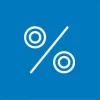Interest is compounded when it is added to your assets rather than withdrawn.
Because the yields you earn are added to your assets, you then earn yields on your yields. This carries on to form the oft underestimated compound interest effect.
Example: You deposit 1000 Swiss francs in an interest earning account with a generous 5% annual percentage yield. In 50 years, without compounding interest, your assets will have grown to 3500 francs. In other words you will have earned 2500 francs of interest.
But apply compounding interest to the same deposit, and you would end up with 11,467.40 francs. That’s a profit of 10,467.40 francs, or more than 4 times what you would have earned if it weren’t for compounding.
Compound interest: Exponential growth
The compound interest effect is a classic example of exponential growth. In 1772 the philosopher Richard Price stunned the world by theorizing that, had a single penny been deposited at a 5% annual percentage yield rate in the year 0, it would have at his time been worth more than 150 earths filled with gold.
Since then, this story of the fictional "Joseph’s penny," which multiplied to astronomical proportions over the centuries, has helped us to fathom the power of compound interest.
Compound interest in practice
Now let’s apply the concept to a more probable calculation. Let’s say you set aside 500 francs per month, starting from your 25th birthday and carrying on non-stop until you are 65.
A 1 percent annual yield rate on your savings, with compounding interest, would leave you with 295,000 francs. Your interest earnings would total 55,000 francs. If you had a 2 percent annual yield rate, you would end up with 366,000 francs of which a tidy 126,000 francs would be interest earnings.
The same investment with yields of 3.5 percent per annum would, over the course of those 40 years, build up to 517,000 francs. You would be half way to being a millionaire.
Think long-term when investing
The following rules of thumb are key to a successful saving or investing experience: Firstly, save over as long a period as you possibly can. That means starting as early as possible and stopping as late as possible. Compounding interest gains in effect every year, so your final years of saving will be the most profitable.
Secondly: Make sure to find an investment opportunity which is rewarding but at the same time secure and cheap. A 1 percent difference in interest rates can add up to thousands of francs over the years. The same applies to costs: 1 percent higher annual costs means 1 percent lower yields.
Savings accounts, bonds and retirement accounts
Swiss residents with a lower tolerance for risk can take advantage of several different savings vehicles. These include classic savings accounts, bonds and retirement accounts. Annual yield rates are currently very low.
Still, it’s worth comparing offers, because even a small difference in interest rates can amount to a fortune over the years. moneyland.ch delivers the most comprehensive financial product comparison tool in Switzerland.
The comparison accounts for compounding interest are based on the number of years you select, so you can quickly and accurately compare the yields offered by different savings options including compound interest.
Last but not least: the leading Swiss compound interest calculator by moneyland.ch bases results on the initial deposit or investment amount, regular additional deposits, the frequency and timing of subsequent deposits (in advance or arrears), the time frame and the interest rate.
More information:
Compound interest calculator
Savings account comparison tool

 Deal of the Day
Deal of the Day 







